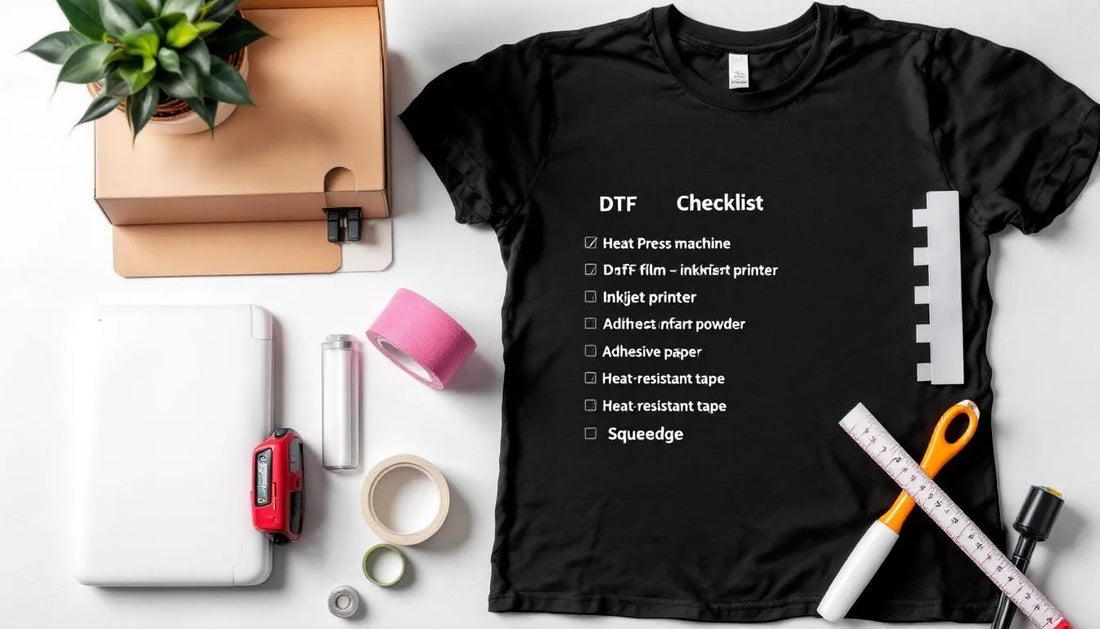
DTF Supplies Checklist: Everything You Need to Start Printing Today
Launching a DTF (Direct-to-Film) workflow is easier when you know exactly what to buy and why. This checklist covers the core equipment, the must-have consumables, and the nice-to-have tools that turn first-day chaos into consistent, profitable production. Wherever possible, we explain not just what to get, but how each item affects print quality, wash durability, and throughput.
Your Core DTF System (Hardware You Can’t Skip)
DTF Printer (with Reliable White-Ink Management)
- Why it matters: White ink settles. You need recirculation and tank agitation to keep pigments in suspension and nozzles healthy.
- What to look for: 2–4 heads (dual white is ideal for dark garments), stable media transport, vacuum platen, anti-static features, and easy service access to caps/wipers/pumps.
- Output goal: Crisp gradients, solid whites, minimal banding at production speeds.
Powder Shaker & Curing Unit (Inline or Manual)
- Inline shaker/curer: Automates powdering and cure in one path (printer → powder → oven). Best for speed and consistency.
- Manual workflow: Tray + convection/curing oven works for low volume, but adds labor and variability. Keep trays clean and powder dry.
- Spec tip: Even heat distribution and adjustable dwell/temperature reduce under/over-curing risks.
Heat Press (Accurate Temp, Time, Pressure)
- Why it matters: Press is the last mile for adhesion and hand feel. Inaccurate temperature or low pressure causes partial bonds and poor wash fastness.
- What to look for: 40 × 50 cm (16 × 20”) or larger platen, reliable pressure gauge, uniform heat, and digital controls.
- Accessories: Teflon/parchment sheets, foam pads for seams/zippers, lint roller.
RIP Software (White Control + ICCs)
- Must-have features: Mirror print, white underbase choke/bleed, spot color support, ICC profiles, queue/tiling for gang sheets.
- Why: Smart white and proper profiling prevent halos, improve color accuracy, and reduce ink waste.
Consumables & Daily-Use Items (The Real “Shopping List”)
DTF Pigment Ink (CMYK + White)
High-gamut CMYK and dense, stable white are non-negotiable. Pair inks to your film and cure settings for predictable results.
- Shop DTF Pigment Ink
- Pro tip: Keep bottles sealed, store within temperature specs, and gently agitate white as recommended.
DTF Hot Peel PET Film (Sheets or Roll)
The film’s coating and thickness influence ink laydown, dot shape, and peel feel. Hot-peel speeds your workflow; verify the recommended press window.
- Shop DTF Hot Peel Film Roll
- Spec tip: Choose a film with consistent matte side, anti-static behavior, and clear peel guidelines (temp/time).
DTF Hot Melt Powder (Adhesive)
Powder weight and melt point shape durability and hand feel. Too much powder = grainy texture; too little = weak bond.
- Shop DTF Hot Melt Powder
- Usage clue: Typical 6–10 g for a chest print. Aim for a thin, even coat that melts to a satin “orange-peel” finish after curing.
Cleaning & Maintenance Solutions
- DTF Strong Cleaning Solution for stubborn clogs and periodic deep maintenance.
- Everyday cleaners/flush for caps, wipers, and capping station; lint-free swabs; waste ink bottle liners.
- Habit: Daily nozzle check + quick wipe prevents most downtime.
Environment & Anti-Static Kit
- Humidity control: Hygrometer + humidifier/dehumidifier (stable 45–60% RH reduces static and banding).
- Anti-static: Ionizer bar/brush for film path; anti-static mat near the printer.
- Air quality: Simple purifier + local ventilation around the curing unit.
QC & Safety Basics
- Measuring tools: IR thermometer (cure temp), stopwatch, small scale (powder grams).
- PPE: Heat gloves, dust mask/respirator as needed, safety glasses.
- Test kit: Standard T-shirts/fabrics for wash tests; record press and cure settings on each test.
Press & Finishing Accessories
- Teflon/parchment sheets, silicone pads for uneven garments, lint rollers, alignment rulers.
- Cooling rack or flat surface for fresh transfers; avoid stacking hot prints face to face.
Nice-to-Have Upgrades (Speed, Consistency, Less Mess)
Inline Take-Up & Powder Recovery
- Take-up reel: Keeps long runs tidy and reduces handling errors.
- Recovery tray: Recycle clean powder to cut waste; store powder sealed and dry.
Color Management & Proofing
- Media-matched ICCs; gray balance/linearization presets for your ink/film combo.
- Keep a reference swatch book of your own DTF prints to align client expectations.
Workflow Templates
- RIP presets per substrate (white density, choke, passes, speed).
- Standardized gang-sheet templates for common shirt sizes and placements.
Day-1 Packing List (Printable)
- ☑ DTF printer with white recirculation + spare caps/wipers/dampers
- ☑ Powder shaker/curer (inline) or tray + curing oven with even heat
- ☑ Heat press (accurate temp/pressure) + Teflon/parchment sheets
- ☑ DTF Pigment Ink (CMYK + White)
- ☑ DTF Hot Peel PET Film (sheets or roll)
- ☑ DTF Hot Melt Powder
- ☑ Strong Cleaning Solution, lint-free swabs, wipes
- ☑ Hygrometer, anti-static brush/ionizer, lint roller
- ☑ IR thermometer, timer, small digital scale
- ☑ RIP software with white/ICC control + gang-sheet templates
- ☑ Test garments for press/wash validation
Setup & First-Run Tips (Avoid the Classic Pitfalls)
Dial In White Underbase
- Start with the vendor’s default density; add a slight choke (inward offset) to prevent white halos.
- Check fine text and gradients; increase passes only if you see banding.
Powder Less Than You Think
- Even, thin coverage = softer hand and better detail retention.
- Use the scale for consistency. If the hand feels crunchy, you’re likely over-powdering or over-curing.
Follow the Film’s Press Window
- Typical: 150–165 °C (302–329 °F), 10–15 s, medium pressure. Verify your film’s datasheet.
- Finish press 5–10 s with a protective sheet to lock in durability.
Standardize & Log
- Document ink lot, film type, powder weight, cure temp/time, press settings, and results.
- Repeatability beats guesswork: same inputs → same outputs → fewer reprints.
Recommended Products (Quick Links)
Final Checklist Before You Print
- Nozzle check is clean; white recirculated/agitated
- Film loaded printable side up; anti-static enabled
- RIP mirrored; white underbase + choke set; passes chosen
- Powder station clean and dry; cure temp verified with IR thermometer
- Press preheated; test garment ready; finishing sheet at hand
Bottom Line
DTF success is a systems game. With the right ink + film + powder combo, stable curing/press settings, and simple QC tools, you’ll ship vibrant, durable transfers from day one—and scale confidently as orders grow.
